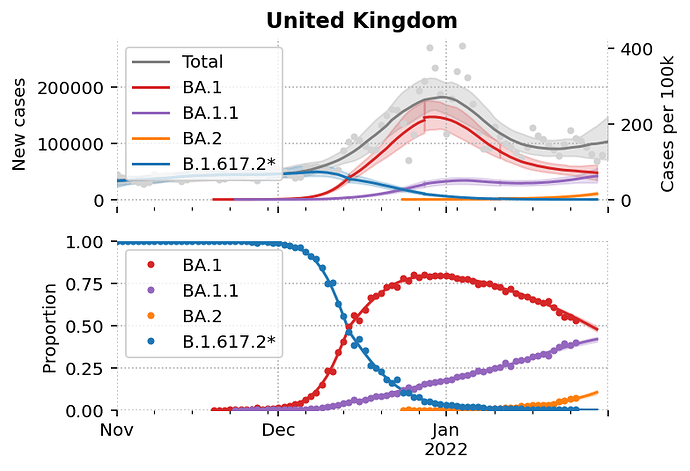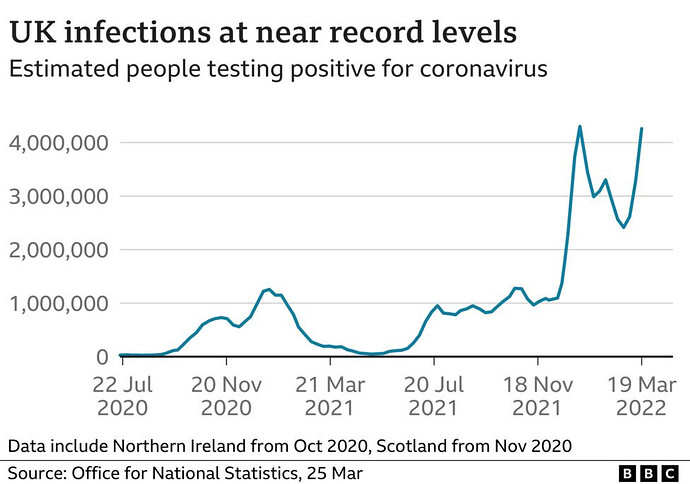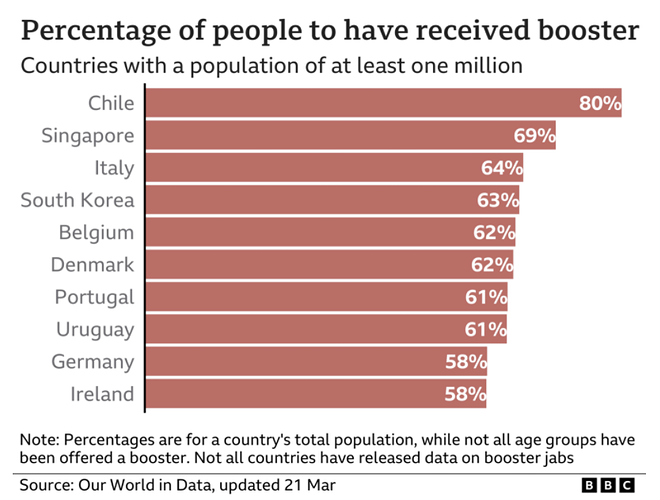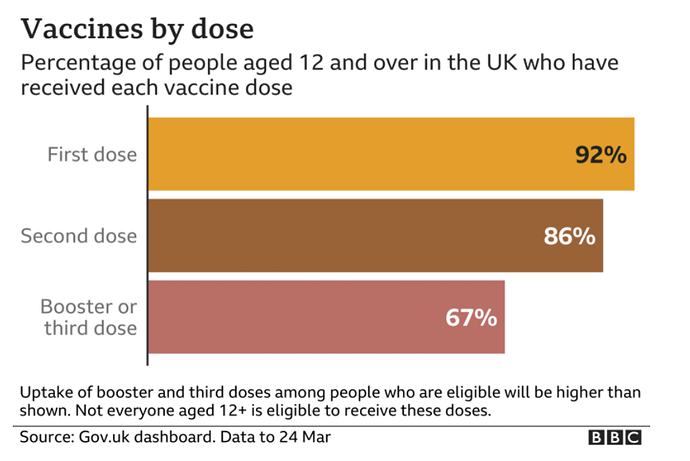two posts to fall into the same old bullshit.
Edited just for you. 100 word post you found an error.
BA.1.159 is original Omicron. OK< I now see the USA was the only country in the world to subcategorise BA.1.1 (for some strange reason). Maybe this one country strain will really protect you guys against the rampant BA.2.
Hmm. About as bad as everywhere else?
If you could let me have more than 2 posts before you fall into the same confrontational bullshit that would be great
It’s the “World Health Organization” not the “US Health Organization”.
If you didn’t come in here trying to score points on your first post, you probably would have had more success avoiding this.
The WHO make no real delineation between the two (BA.1 and BA1.1)
Here’s the full copy paste from CN’s link (and only the US bothered to split the two) - I’ve bolded the only 2 mentions. Can you find me agraph other than a USA version that bothers to split them? What’s the difference between BA.1 and BA1.1?
As part of its on-going work to track variants, WHO’s Technical Advisory Group on SARS-CoV-2 Virus Evolution (TAG-VE) met yesterday to discuss the latest evidence on the Omicron variant of concern, including its sublineages BA.1 and BA.2.
Based on available data of transmission, severity, reinfection, diagnostics, therapeutics and impacts of vaccines, the group reinforced that the BA.2 sublineage should continue to be considered a variant of concern and that it should remain classified as Omicron. The group emphasized that BA.2 should continue to be monitored as a distinct sublineage of Omicron by public health authorities.
The Omicron variant of concern is currently the dominant variant circulating globally, accounting for nearly all sequences reported to GISAID. Omicron is made up of several sublineages, each of them being monitored by WHO and partners. Of them, the most common ones are BA.1, BA.1.1 (or Nextstrain clade 21K) and BA.2 (or Nextstrain clade 21L). At a global level, the proportion of reported sequences designated BA.2 has been increasing relative to BA.1 in recent weeks, however the global circulation of all variants is reportedly declining.
BA.2 differs from BA.1 in its genetic sequence, including some amino acid differences in the spike protein and other proteins. Studies have shown that BA.2 has a growth advantage over BA.1. Studies are ongoing to understand the reasons for this growth advantage, but initial data suggest that BA.2 appears inherently more transmissible than BA.1, which currently remains the most common Omicron sublineage reported. This difference in transmissibility appears to be much smaller than, for example, the difference between BA.1 and Delta. Further, although BA.2 sequences are increasing in proportion relative to other Omicron sublineages (BA.1 and BA.1.1), there is still a reported decline in overall cases globally.
Studies are evaluating the risk of reinfection with BA.2 compared to BA.1. Reinfection with BA.2 following infection with BA.1 has been documented, however, initial data from population-level reinfection studies suggest that infection with BA.1 provides strong protection against reinfection with BA.2, at least for the limited period for which data are available.
While reaching the above determination, the TAG-VE also looked at preliminary laboratory data from Japan generated using animal models without any immunity to SARS-CoV-2 which highlighted that BA.2 may cause more severe disease in hamsters compared to BA.1. They also considered real-world data on clinical severity from South Africa, the United Kingdom, and Denmark, where immunity from vaccination or natural infection is high: in this data, there was no reported difference in severity between BA.2 and BA.1.
WHO will continue to closely monitor the BA.2 lineage as part of Omicron and requests countries to continue to be vigilant, to monitor and report sequences, as well as to conduct independent and comparative analyses of the different Omicron sublineages.
The TAG-VE meets regularly and continues to discuss available data on transmissibility and severity of variants, and their impact on diagnostics, therapeutics, and vaccines.
I can’t emphasize enough here that the WHO isn’t the US. The “World” part ought to give it away.
I’m sure today is finally the day where arguing with churchill will accomplish something other than making this thread unreadable.
No one is saying that. Please go troll somewhere else.
lol it’s a failure of moderation that churchill is still allowed to post in this thread
How might the prevalence of B.1.1 (in the US) prevent the spread of BA.2 in the US?
it’s literally in the end of the quote there
Silly me, eh? Who knew I could have hypthesized rather than cite.
Peer reviewed hypthesized? Hunch?
I did find B.1.1 in UK - hypothesis didn’t work out here
then

Absolutely incredible that you pop into this thread guns blazing about how there’s no such thing as BA1.1 outside of the imaginations of Americans, no one else in the world tracks it because it’s irrelevant, and then, MIRACULOUSLY, you come across a source tracking BA1.1 in the UK specifically without a hint of introspection.
But, uh, yeah bro. When BA1.1 is a pretty small minority of your overall omicron cases, then it’s going to offer much less protection against BA.2 at the population level, if BA1.1 is indeed more protective, as hypothesized
Thanks. Not much changed here, other than threads being full of the same 10 posters.
That’s called self-correction, Wookie. Some humans are capable of this.
As an expert in the field, can you answer my question? (Miraculous you miss the question you hypothesise about.
It’s a failure of moderation I can’t reply with the same content-less attack - sure one day you’ll find love, SUB
No, a normal human response to being 100% dead wrong in your accusation is to apologize, not to move on like it never happened.
I must have missed your apology on Alpha not likely to hit the US. Also, germ theory.
Sorry Wookie, B.1.1 was reported in two countries, I missed that. Irrelevant thou IMO. Would have had it own BA.x if the mutation confered anything else (like BA.2?)
Over the coming months, you’ll see BA.2 being transmitted* by ‘quite a clip’ by the vaccinated, more than BA.1. * deaths in the vaccinated still way lower than the unvaxxed, but contraction / transmission - BA.2 doesn’t care (hence 4th jab requirement and soon)
Gonna answer the question soon?
Why do you have to make these personal insults?
PM me if you want a serious answer to your aimless line of questioning - why does SUB have to make his posts (and where are your questions asking him the same?)
Ever notices who attacks first, Goofy? Never me. But pile on.
Surely these posters seek a response from their non-content attacks. They could just chose to STFU.
I’ll put em on ignore.



